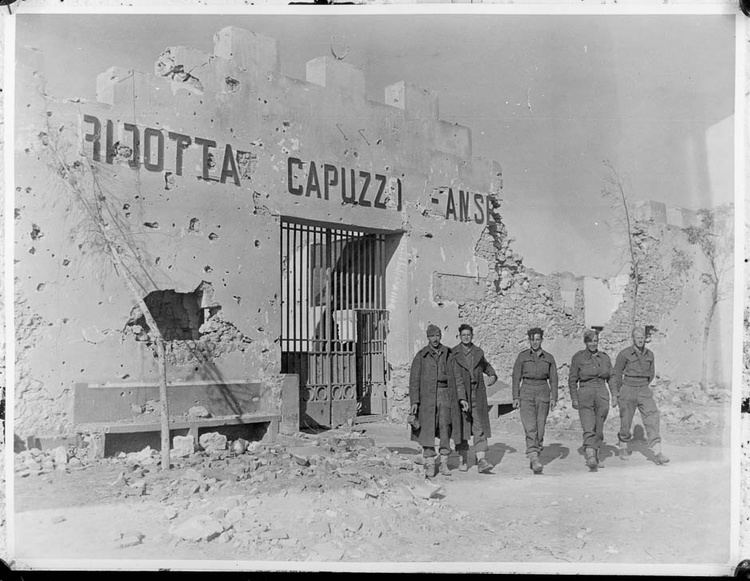 | ||
Similar Mareth Line, Marble Arch, Tripoli Cathedral, Tripoli Grand Prix, Benghazi Cathedral | ||
Epic arma ww2 fort capuzzo june 1940
Fort Capuzzo (Ridotta Capuzzo) was a fort in the colony of Italian Libya, near the Libyan-Egyptian border and next to the Italian Frontier Wire. The Litoranea Balbo (Via Balbia) ran south from Bardia to Fort Capuzzo, 13 kilometres (8 mi) inland, west of Sollum, then east across the Egyptian frontier, to the port over the coastal escarpment. The fort was built during Italian colonial repression of Senussi resistance in the Second Italo-Senussi War (1923–1931), as part of a barrier on the Libya-Egypt and Libya-Sudan borders.
Contents

The Frontier Wire and a series of forts including Fort Capuzzo, were used to stop the Senussi from moving freely across the border. The fort had four crenellated stone walls around a yard, with living quarters on the edges and was the base for border guards and Italian army armoured car patrols. A track ran south from the fort, just west of the frontier wire and the border, to Sidi Omar, Fort Maddalena and Giarabub. The fort changed hands several times during the Western Desert Campaign (1940–1943) of the Second World War.

Background
In 1922, Benito Mussolini continued the Riconquista of Libya, in the Second Italo-Sanussi War (1921–1931). The Frontier wire was built by the Italian army, under the command of General Rodolfo Graziani, in the winter of 1930–1931, as a means to repress Senussi resistance against the Italian colonisation. The frontier wire and fort system was used to hinder the movement of Senussi fighters and materials from Egypt. The wire comprised four lines of 1.7-metre (5.6 ft) high stakes in concrete bases, laced with barbed wire 320 kilometres (200 mi) long, just inside the border from El Ramleh on the Gulf of Sollum, past Fort Capuzzo to Sidi Omar, then south, slightly to the west of the 25th meridian east, the Libya-Egypt and Libya-Sudan borders. Three large forts at Amseat (Fort Capuzzo), Scegga (Fort Maddalena) and Giarabub and six smaller ones at El Ramleh on the gulf of Sollum, at Sidi Omar, Sceferzen, Vescechet, Garn ul Grein and El Aamara along the wire. The wire was patrolled using armoured cars and aircraft from the forts, by the Italian army and border guards, who attacked anyone seen in the frontier zone.
1940
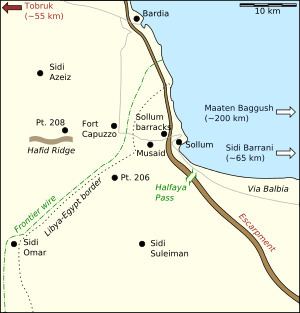
On 14 June, within a week of the Italian declaration of war on Britain (10 June 1940), the 7th Hussars and elements of the 1st Royal Tank Regiment, Gladiators of 33 Squadron Royal Air Force (RAF) and Blenheims of 211 Squadron captured Fort Capuzzo, as the 11th Hussars took Fort Maddalena about 60 miles (97 km) further south. The fort was not occupied long for lack of troops and equipment but demolition parties visited each night to destroy Italian ammunition and vehicles. For the rest of June, the British patrolled to the north, south and west and began the Siege of Giarabub. The Italian 10th Army concentrated in the area from Bardia to Tobruk and brought forward the Maletti Group, a combined tank, infantry and artillery force, equipped with a company of Fiat M11/39 medium tanks, superior to the older L3/33 tankettes.
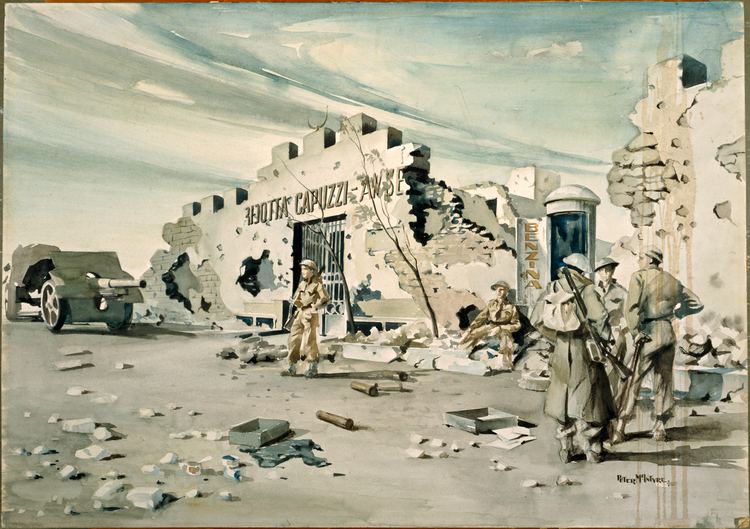
The Italians reoccupied Fort Capuzzo and held it with part of the 2nd Blackshirt Division (28 October) (Luogotenente Generale Francesco Argentino). On 29 June, the Maletti Group repulsed British tanks with its artillery and then defeated a night attack. During the frontier skirmishes from 11 June – 9 September, the British claimed to have inflicted 3,500 casualties for a loss of 150 men. On 16 December, during Operation Compass (9 December 1940 – 9 February 1941), the 4th Armoured Brigade of the Western Desert Force captured Sidi Omar and the Italians withdrew from Sollum, Fort Capuzzo and the other frontier forts; Number 9 Field Supply Depot was established at the fort for the Armoured Division.
1941
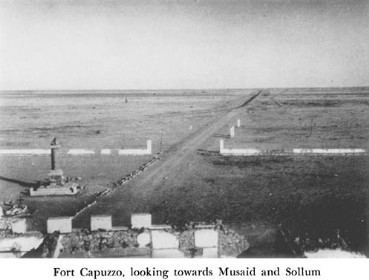
On 10 April, after the Axis advance from El Agheila, small British mobile columns began to harass Afrika Korps units around Fort Capuzzo, that was captured by the Germans on 12 April but attacks by Kampfgruppe Herf from 25–26 April, led the British columns to fall back. During Operation Brevity (15–16 May), an operation to capture the area between Sollum and the fort and inflict casualties, the 22nd Guards Brigade Group and the 4th RTR was to capture the fort and then attack northwards. The operation began on 15 May and the fort was captured by the 1st Durham Light Infantry (1st DLI) and a squadron of I tanks. A counter-attack by II Battalion, Panzer Regiment 5 (with eight operational tanks) inflicted many losses and forced the 1st DLI back to Musaid. The German force advanced from Fort Capuzzo on the following afternoon.
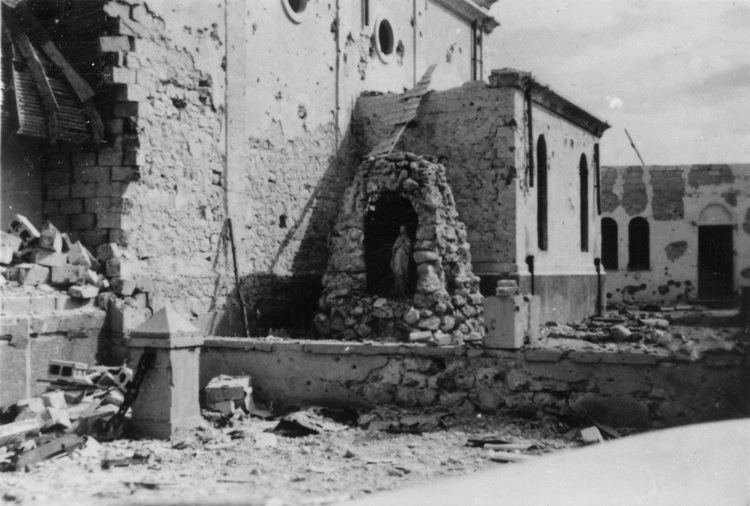
Three Italian battalions with artillery from the 102nd Motorised Division Trento took over the area between Sollum, Musaid and Fort Capuzzo. On the afternoon of 15 June, the 7th Royal Tank Regiment (7th RTR) attacked Fort Capuzzo during Operation Battleaxe (15–17 June and scattered the defenders. The British tanks broke through but infantry were slow to follow up and the tanks were not able rapidly to exploit the success. Next day, the 22nd Guards Brigade consolidated at the fort, Panzer Regiment 8 attacked in the area and was repulsed by the 4th Armoured Brigade. German attempts to work round the British flank failed but reduced the tank regiments in the area to 21 runners. On 17 June, the danger of encirclement increased as German attacks reached Sidi Suleiman and the 22nd Guards Brigade was ordered to retreat at 11:00 a.m.; the remnants of the armoured brigades covered the British withdrawal, eventually to the start line, assisted by air cover from the RAF. On 22 November, the fort was captured by the 2nd New Zealand Division, during Operation Crusader (18 November–30 December), which then advanced on Tobruk, apart from the 5th New Zealand Brigade which remained to capture the Sollum barracks.
1942

Axis forces recaptured the fort around 22 June 1942, after the Battle of Gazala 26 May – 21 June 1942) and captured 500 long tons (510 t) of fuel and 930 long tons (940 t) of foodstuffs, despite demolitions since the British withdrawal from Gazala has begun on 14 June. After the Second Battle of El Alamein (23 October–11 November 1942), Fort Capuzzo changed hands for the last time. German rearguards retired from Sidi Barrani on 9 November; next day, the 22nd Armoured Brigade advanced on Fort Capuzzo from the south and by 11 November, the last Axis troops had withdrawn from the frontier, despite orders to hold the area from Halfaya to Sollum and Sidi Omar.
Post war
After the Allied conquest in 1943, Tripolitania and Cyrenaica were ruled under the British Military Administration of Libya until Libyan independence in 1951, as a kingdom under Muhammad Idris bin Muhammad al-Mahdi as-Senussi (King Idris of Libya). Fort Capuzzo and the frontier wire disappeared into obscurity.
